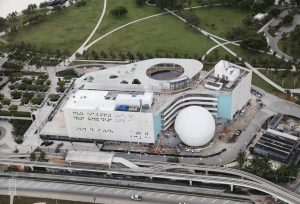Hurricane Matthew takes aim at South Florida’s construction boom

Construction workers are scurrying to batten down the Patricia and Phillip Frost Museum of Science job site. Interior exhibit rooms are being used to store equipment and supplies. Anything too big to be brought in was tied down. Frost Science
The builder’s storm preparation plan is in full-on mode.
“If you start planning for a hurricane the week it comes you are in deep trouble,” said MacAdam Glinn, who heads Skanska USA in South Florida, overseeing its active construction projects including the Frost Science Museum. “We put our hurricane plans in our project plans.”
Over at Moss Construction, which has several tower cranes dotting the downtown Miami skyline, crews are at also at work battening down, but the tower cranes, unlike mobile cranes, aren’t lowered but rather are set to “weather vane” or spin with the wind, said Scott Gerard, vice president of environmental, health and safety for Moss Construction, which has about 20 projects ongoing in South Florida, including Brickell Heights, 1010 Brickell and SLS downtown, Icon-Fort Lauderdale and the All-Aboard stations in Broward and Palm Beach Counties. In addition to diligent housekeeping outside, there are computers, architectural drawings and documents to keep safe and dry, and although it isn’t glamorous, all those porto-potties have to be secured, he said.
It’s not clear yet if South Florida will take a direct hit from Hurricane Matthew — but with a building boom underway across the region, no construction firm wants to be caught unprepared.
That’s because unfinished buildings invite in water and wind that could increase the damage. Window openings without glass must to be boarded up so the winds don’t create uplift and potentially rip off the roof. Those decorative privacy screens attached to fences around job sites can become sails — those have to come down. Extra generators and pumps are brought in for post-storm clean up. And how about supplies and debris on a construction site, like timber and roof tiles and tools?
“If you don’t clean up your site, every piece of timber and shoring and tools become a flying missile that now only damages building but could endanger people — and it is 100 percent preventable,” said Glinn of Skanska, with projects ongoing at Broward Health North, Chris Everett Children’s Hospital and Barry University, among others.
Cleaning up debris and securing loose objects at job sites as well as residences and commercial properties is also the law, said Greenberg Traurig attorney Robert S. Fine. In Miami-Dade, county law is triggered once a severe weather alert goes into effect. In Broward, a building official will give the order, but in both cases, besides the potential toll on persons and property there could be legal consequences for not complying, Fine said.
Jose A. Faria, a senior instructor with the School of Construction within Florida International University’s College of Engineering and Computing and a construction safety expert, said fortunately the government offers a playbook.
The Occupational Safety and Health Administration (OSHA) partners with real estate and construction trade associations to get its information out about how construction companies should prepare and respond to a hurricane threat. OSHA recommends that every company has a safety plan in place, with someone appointed to direct securing and evacuating the construction site before the storm as well as cleanup and restarting the job site after the hurricane has passed. “Follow the government guidelines — that is extremely important,” Faria said.
While the proliferation of job sites around South Florida could make residents nervous for their safety, it shouldn’t, said Moss’ Gerard. Safety officials at Moss and its competitors openly share best practices for hurricane preparedness with one another because “it only makes South Florida stronger,” Gerard said.
And one other thing that shouldn’t make residents nervous: all those tower cranes seemingly blowing freely in the wind during a storm. “That’s by design, for safety,” Gerard said.
BATTENING DOWN COMMERCIAL PROPERTIES
As builders were securing construction sites, real estate property managers were taking measures of their own to ensure that South Florida’s office buildings, shopping centers and warehouses were protected.
Keeley O’Leary has launched her company’s hurricane plan for the 50 office, medical and retail properties with about 6.6 million square feet of space that it manages in South Florida. The senior property manager with Colliers International South Florida and her team had already communicated with tenants of every property that after a hurricane warning goes into effect they will have just two more hours to move or remove their valuables and important papers from their offices. Many of them had gotten a head start, however; they are all encouraged to have their own hurricane plans.
After the two-hour warning, each building is shut down, allowing the tenants to go home and take care of their families until after the storm. But for O’Leary’s staff, the work has just begun. They have an operational checklist tailored to each building with a chain of command and a first responders’ list that would even make the military proud. “Make sure everyone knows their part,” she said. “This is a severe threat, and you have to take it seriously.”
For the exteriors, “it’s very simple, we bring it in or tie it down,” O’Leary said. The teams trim tree limbs and sandbag the doors if it is an area prone to flooding. Inside, computer equipment is wrapped and the elevators are parked midway up in case of flooding. Take photos or video of everything before the storm, she advised.
Once the storm has passed, O’Leary has an army of contractors at the ready to do repairs and cleanup needed. Tenants and their employees are not allowed back into the buildings until after a Colliers safety response team has cleared it for reopening.
